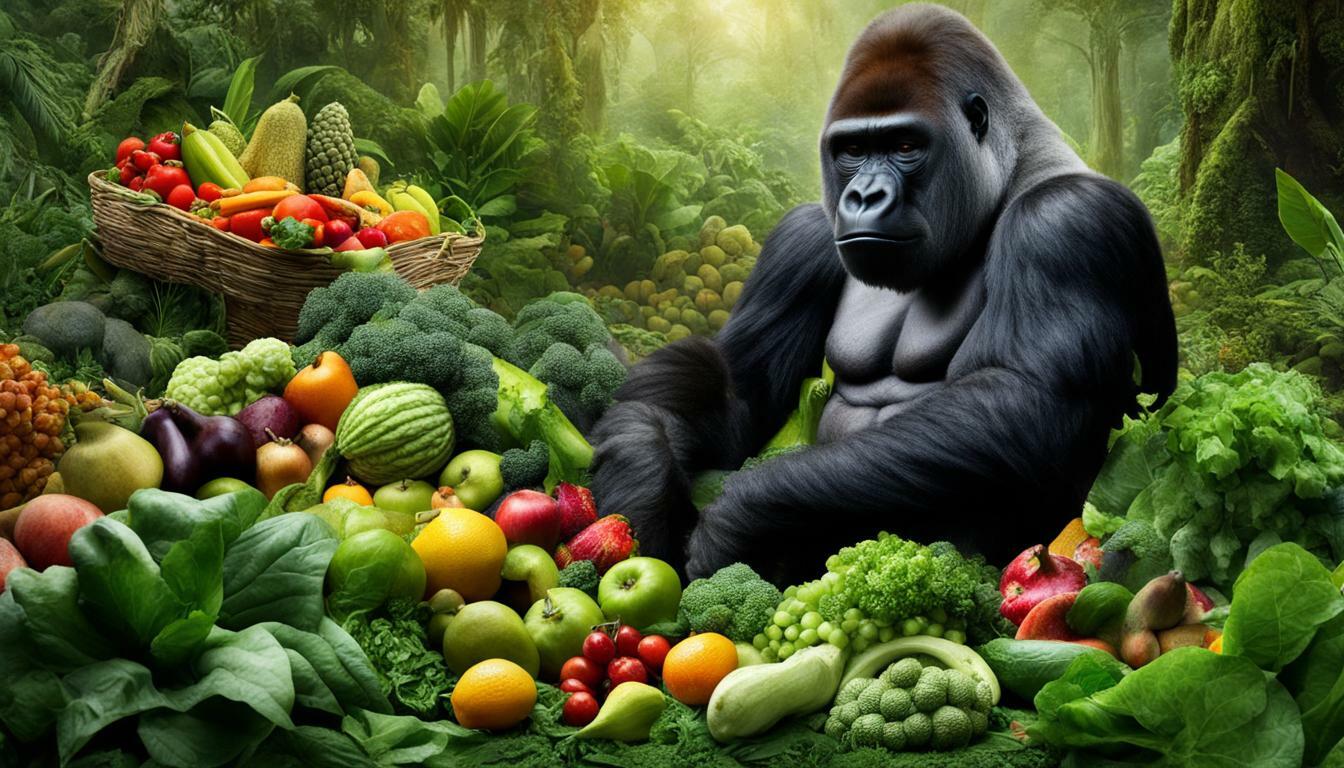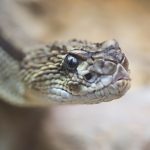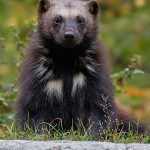Gorillas have a varied diet depending on their subspecies and the season. They consume parts of numerous plant species, including leaves, fruits, seeds, barks, stems, pith, bamboo shoots, and occasional small animals. Their nutritional needs are met through their herbivorous diet and digestive system. Gorillas exhibit selective foraging behavior, using their strength to break apart vegetation. They spend a significant amount of time each day, approximately 50%, eating and foraging for food. While gorillas rarely drink as their diet provides them with sufficient water content, they obtain water from succulent vegetation. Gorillas also have minimal interactions with humans and tend to avoid attacking unless provoked.
Key Takeaways:
- Gorillas consume various plant species, including leaves, fruits, seeds, barks, stems, and pith.
- They occasionally consume small animals such as insects, rodents, termites, lizards, and snails.
- Gorillas spend approximately 50% of their day eating and foraging for food.
- Their diet provides them with sufficient water content, resulting in rarely drinking water.
- Gorillas have minimal interactions with humans and typically do not attack unless provoked.
What Do Gorillas Eat?
Gorillas primarily eat green leaves, juicy fruits, seeds, tree barks, stems, pith, and bamboo shoots. Their diet varies depending on their subspecies and the season. For example, Western lowland gorillas consume parts of at least 97 plant species, with about 67% of their diet consisting of fruit. Eastern lowland gorillas consume parts of at least 104 plant species, while mountain gorillas consume parts of at least 142 plant species.
Gorillas rely on vegetation as their main source of sustenance. They are able to survive on a herbivorous diet, but due to the low nutritional quality of vegetation, they need to consume a larger quantity. In fact, adult male gorillas can consume more than 18 kg (40 lbs.) of vegetation per day. They use their incredible strength to break apart vegetation, allowing them to access the parts they prefer to eat. Gorillas are selective foragers and eat only certain parts of the vegetation, such as leaves, fruits, and seeds.
Although gorillas primarily rely on plant-based foods, they occasionally consume small animals as well. Insects, rodents, termites, lizards, and snails make up a small part of their diet. However, these animal-based foods are not a significant portion of their overall food intake.
Gorilla Feeding Habits: Selective Foragers and Daily Routine
Gorillas spend about 50% of their day engaging in feeding and foraging activities. They travel long distances in search of food, as their diet requires a variety of plant species. Gorillas are known for their selective foraging habits, carefully choosing which parts of the vegetation to eat. This behavior allows them to maximize their nutritional intake from the available resources.
Throughout the day, gorillas exhibit a routine of feeding, resting, and socializing. They start their day by foraging for breakfast, then take a break to rest during the midday heat. Afterward, they resume their feeding activities, often moving to different areas in search of fresh vegetation. This daily routine ensures that gorillas meet their nutritional needs and maintain their large and powerful bodies.
| Plant-based Foods | Animal-based Foods |
|---|---|
|
|
In conclusion, the vegetarian diet of gorillas consists of a wide variety of plant-based foods, with green leaves and fruits being the primary components. Their feeding habits include selective foraging and the consumption of a large quantity of vegetation. While they occasionally consume small animals, their diet is primarily herbivorous. Understanding the dietary preferences and feeding habits of gorillas provides valuable insights into their natural behavior and nutritional needs.
Nutritional Needs of Gorillas
Gorillas are able to survive on vegetation such as leaves, stems, roots, and grasses, but they must consume a larger quantity due to the low nutritional quality. Their herbivorous diet is primarily composed of green leaves, juicy fruits, seeds, tree barks, stems, pith, and bamboo shoots. These food sources provide gorillas with the necessary nutrients to maintain their health and well-being.
Gorillas have specific nutritional needs that are met through their varied diet. They require a high intake of fiber, which is obtained from the plant materials they consume. Fiber aids in digestion and helps regulate their digestive system. Additionally, gorillas need a sufficient intake of vitamins and minerals to support their bodily functions.
While gorillas are primarily herbivorous, it is worth noting that they occasionally consume small animals such as insects, rodents, termites, lizards, and snails. These animal proteins supplement their diet, providing them with additional nutrients.
Table: Nutritional Requirements of Gorillas (per day)
| Nutrient | Quantity |
|---|---|
| Fiber | High intake |
| Vitamins | Varied intake |
| Minerals | Varied intake |
| Animal proteins | Occasional intake |
Gorillas spend a significant portion of their day eating and foraging for food. Adult male gorillas can consume more than 18 kg (40 lbs.) of vegetation per day to meet their nutritional needs. Their selective foraging habits and use of strength to break apart vegetation ensure they consume only the most nutritious parts of plants, maximizing their nutrient intake.
Overall, the diet and feeding habits of gorillas are tailored to ensure their survival and optimal health. The variety of plant materials they consume, combined with occasional animal proteins, provide them with the necessary nutrients to thrive in their natural habitat.
Feeding Behavior of Gorillas
Gorillas use their strength to break apart vegetation and are selective foragers, eating only parts of the vegetation. This behavior is influenced by their need to consume a large quantity of low-nutrient vegetation to meet their nutritional needs. Although they primarily eat green leaves, gorillas also enjoy indulging in juicy fruits, seeds, tree barks, stems, pith, and bamboo shoots. Occasionally, they supplement their diet with small animals such as insects, rodents, termites, lizards, and snails.
To sustain themselves, gorillas spend approximately 50% of their day eating and foraging. They are skilled at identifying the most nutritious parts of plants and often discard the rest. Their mastery as selective foragers enables them to optimize their intake of essential nutrients. As they traverse long distances in search of food, gorillas come across a wide variety of plant species, consuming parts of at least 97 different types for western lowland gorillas, 104 for eastern lowland gorillas, and 142 for mountain gorillas.
Gorillas’ feeding behavior is closely tied to their habitat and subspecies. While the western lowland gorillas’ diet consists of approximately 67% fruit, the eastern lowland gorillas and mountain gorillas expand their food choices to include a wider range of plant species. This adaptation allows them to thrive in their respective environments and maintain their health and vitality.
| Feeding Behavior of Gorillas | Percentage of Diet |
|---|---|
| Fruits | 67% |
| Leaves, stems, and grasses | Varies depending on subspecies and season |
| Bamboo shoots | Varies depending on subspecies |
| Insects, rodents, termites, lizards, and snails | Occasional supplement to vegetation |
Food Sources for Gorillas
Gorillas consume parts of numerous plant species, with Western lowland gorillas relying on at least 97 plant species and Eastern lowland gorillas and mountain gorillas consuming parts of even more. Their diet consists of a variety of vegetation, including green leaves, juicy fruits, seeds, tree barks, stems, pith, and bamboo shoots. These plant-based foods provide the necessary nutrients for gorillas to thrive in their natural habitats.
Gorillas are selective foragers, meaning they choose only certain parts of the vegetation to eat. They use their strength to break apart the plants and extract the parts that are most beneficial. This selective foraging behavior helps them optimize their energy expenditure and ensure they are consuming the most nutritious portions of the plants.
Additionally, gorillas occasionally consume small animals such as insects, rodents, termites, lizards, and snails. While these animal-based foods make up a small portion of their diet, they can provide additional protein and nutrients. However, the majority of their nutritional needs are met through the consumption of plant-based foods.
| Plant Species | Western Lowland Gorillas | Eastern Lowland Gorillas | Mountain Gorillas |
|---|---|---|---|
| Leaves | ✓ | ✓ | ✓ |
| Fruits | ✓ | ✓ | ✓ |
| Seeds | ✓ | ✓ | ✓ |
| Barks | ✓ | ✓ | ✓ |
| Stems | ✓ | ✓ | ✓ |
| Pith | ✓ | ✓ | ✓ |
| Bamboo Shoots | ✓ | ✓ | ✓ |
Gorillas spend a significant portion of their day eating and foraging for food. They travel long distances to find the necessary plant species to fulfill their nutritional needs. Despite the abundance of plant-based food sources available to them, gorillas rarely drink water in the wild. This is because the succulent vegetation they consume provides them with sufficient water content, minimizing their need for additional hydration.
Understanding the food sources that gorillas rely on is crucial for their conservation and habitat preservation. By ensuring that these plant species are protected and available, we can help ensure the long-term survival of these magnificent creatures in their natural environments.
Water Consumption of Gorillas
Gorillas rarely drink in the wild because they consume succulent vegetation that is high in water content. Their diet consists of various plant parts, including green leaves, juicy fruits, seeds, tree barks, stems, pith, and bamboo shoots. These plants naturally contain a significant amount of water, providing gorillas with sufficient hydration.
Unlike humans, who often rely on drinking water, gorillas obtain most of their hydration from the moisture present in the plants they consume. This allows them to survive without the need for regular drinking water. It’s a fascinating adaptation that demonstrates their incredible ability to thrive in their natural habitat.
Gorillas are known for their selective foraging habits, consuming only certain parts of the vegetation they encounter. They use their immense strength to break apart tough plant materials, such as stems and branches, to access the nutritious parts inside. This behavior ensures they obtain the necessary nutrients while conserving energy.
| Gorilla Diet | Water Content (%) |
|---|---|
| Green Leaves | 80-90% |
| Juicy Fruits | 80-90% |
| Seeds | 5-10% |
| Tree Barks | 40-75% |
| Stems | 65-85% |
| Pith | 80-90% |
| Bamboo Shoots | 80-95% |
It’s important to note that while water consumption isn’t a prominent activity for gorillas, they still need access to freshwater sources for other purposes, such as bathing and hygiene. These water sources help maintain their overall well-being and social interactions within their groups.
In Conclusion
Gorillas have adapted to their environment by consuming a diet rich in succulent vegetation, which reduces their need for regular drinking water. This unique adaptation reflects their remarkable ability to thrive on the resources available in their natural habitat.
Understanding the water consumption habits of gorillas not only provides insight into their conservation needs but also highlights the incredible diversity of adaptations found in the animal kingdom.
Gorillas and Humans
Gorillas rarely attack humans unless provoked and have a peaceful coexistence with humans in their natural habitat. Despite their size and strength, gorillas are typically gentle and non-aggressive animals. They are known for their social behavior, living in close-knit family groups led by a dominant silverback male. These intelligent creatures display complex emotions and exhibit social bonds similar to those seen in human societies.
Interactions between gorillas and humans are primarily observed in protected areas where gorilla trekking is a popular activity. Tourists from around the world visit these areas to catch a glimpse of these magnificent creatures in their natural habitat. Through regulated and guided tours, visitors have the opportunity to observe gorillas from a safe distance, minimizing any potential disturbance to the animals.
It’s important to note that while gorillas generally do not pose a threat to humans, caution and respect should always be exercised. It is crucial to follow the guidance of trained guides and park rangers to ensure both the safety of visitors and the welfare of the gorillas. By adhering to ethical guidelines and maintaining a respectful distance, visitors can enjoy a unique and memorable experience while ensuring the conservation and protection of these incredible animals.
Conclusion
In conclusion, the gorilla diet and feeding habits are diverse, with gorillas consuming a variety of plant species and occasionally small animals. Gorillas have a varied diet depending on their subspecies and the season. Western lowland gorillas consume parts of at least 97 plant species, with 67% of their diet consisting of fruit. Eastern lowland gorillas consume parts of at least 104 plant species, while mountain gorillas consume parts of at least 142 plant species.
Gorillas primarily eat green leaves, juicy fruits, seeds, tree barks, stems, pith, and bamboo shoots. They occasionally consume small animals such as insects, rodents, termites, lizards, and snails. Adult male gorillas can consume more than 18 kg (40 lbs.) of vegetation per day. Gorillas use their strength to break apart vegetation and are selective foragers, eating only parts of the vegetation. They spend 50% of their day eating and foraging, traveling long distances to find food.
Gorillas have developed a digestive system that allows them to survive on vegetation such as leaves, stems, roots, and grasses, although they must consume a larger quantity due to the low nutritional quality. Despite this, gorillas rarely drink in the wild because their diet consists of succulent vegetation that is high in water content. Their diet varies slightly depending on the subspecies, but overall, gorillas are able to meet their nutritional needs through their herbivorous diet.
It is important to note that gorillas rarely attack humans unless provoked. Despite their strength and size, gorillas are generally peaceful creatures. Understanding their diet and feeding habits helps to promote coexistence and conservation efforts for these incredible animals.
How Does Gorilla Diet Relate to Habitat Destruction?
Understanding gorilla habitat destruction is crucial when analyzing their diet. Gorillas rely on a diverse range of plant species, but with their habitats shrinking rapidly due to deforestation and human encroachment, their food sources are diminishing. This leads to a decline in their available nourishment and can ultimately harm their survival. Protecting gorilla habitats is essential to preserve their natural diet and ensure their long-term existence.
FAQ
Q: What do gorillas eat?
A: Gorillas have a varied diet that includes green leaves, juicy fruits, seeds, tree barks, stems, pith, bamboo shoots, and occasional small animals.
Q: How much vegetation do adult male gorillas consume per day?
A: Adult male gorillas can consume more than 18 kg (40 lbs.) of vegetation per day.
Q: What percentage of a gorilla’s diet consists of fruit?
A: Depending on the subspecies, gorillas’ diets can consist of 67% fruit for western lowland gorillas, parts of at least 104 plant species for eastern lowland gorillas, and parts of at least 142 plant species for mountain gorillas.
Q: Do gorillas drink water?
A: Gorillas rarely drink water in the wild because the succulent vegetation they consume is high in water content.
Q: What are the main sources of food for gorillas?
A: Gorillas obtain their food from various sources, including leaves, fruits, seeds, barks, stems, pith, and bamboo shoots.
Q: How much time do gorillas spend eating and foraging?
A: Gorillas spend approximately 50% of their day eating and foraging.
Q: Do gorillas attack humans?
A: Gorillas rarely attack humans unless provoked.
Q: How does the gorilla diet vary depending on the subspecies?
A: The gorilla diet may vary slightly depending on the subspecies, with different plant species being consumed.







